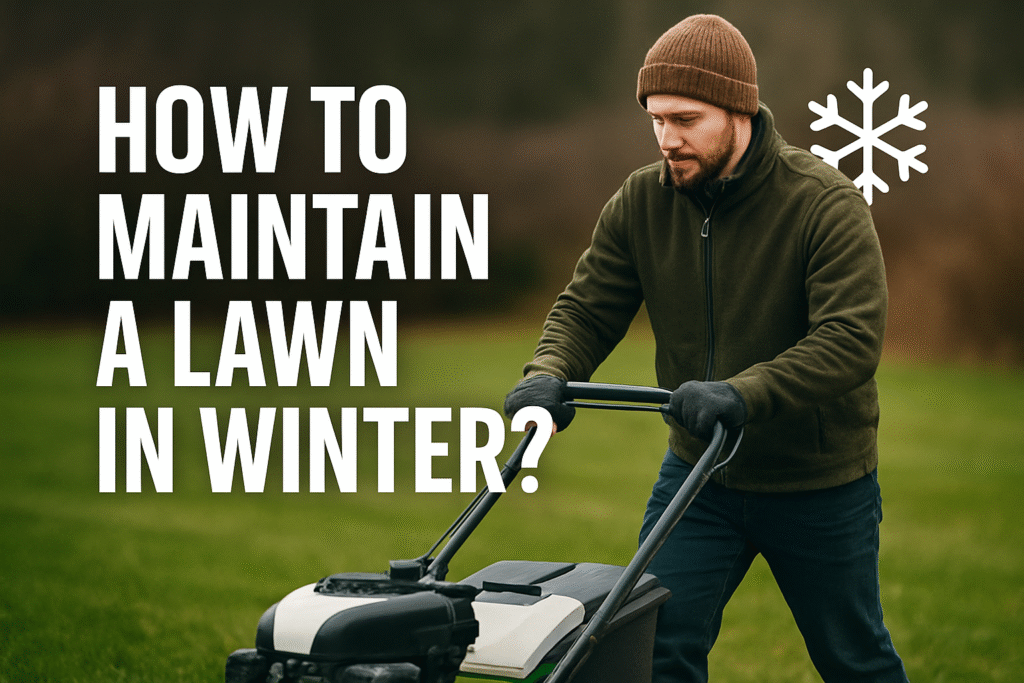Maintaining a healthy lawn doesn’t stop when the temperature drops. Winter weather can be tough on your lawn, but with a little groundwork, it can survive the cold and come back strong in the spring. So, if you have ever wondered what to do with your yard in winter here, and how to maintain a lawn in winter, you will find the whole process for the maintenance of a lawn during winter, along with tips and preventive measures.
Why Winter Lawn Care Matters
When the cold weather arrives and your lawn looks dormant, it’s easy to think that it requires less care. But neglecting winter lawn care can lead to damage that shows up in the spring as patchy, weak, or diseased grass. A lush winter lawn is not a matter of luck, nor does it happen overnight. It takes careful planning and knowledge of how grass plants behave when they are under stress from frost, cold temperatures, and less sunlight.
How Cold Weather Affects Grass
Cold temps slow grass growth, limit photosynthesis, and may even put some turf types into dormancy. Frost affects the blades and roots, and extended periods of freezing may weaken grass health. There is danger in not protecting the lawn from winter stresses that can expose the turf to disease and the possibility of thinning.
Preventing Winter Lawn Damage
There are numerous threats your lawn faces when winter arrives. Snow mold is a fungal disease that is encouraged by compressed snow layers. Frost heave, where soil expands and contracts, can lift grass and cause root damage. Preventative measures, including raking leaves, not compacting the soil, and applying fungicide in the late fall, can avoid these problems.
Benefits of Proper Winter Lawn Maintenance
- Faster Spring Recovery: Winterized lawns snap back faster as temperatures peak.
- Deeper Root System: Fall care promotes a stronger, more vigorous root system.
- Reduced Risk of Diseases: The right care will decrease the risk of snow mold, fungi, and other common winter problems.
- Easier Weed and Pest Control: With a thick, lush winter lawn, it becomes more difficult for weeds and pests to take hold.
- Better Appearance All Year: Cleaner and more consistent than dormancy.
- Long-term Lawn Health: Regular maintenance promotes a healthier, more robust lawn.
Preparing Your Lawn for Winter
The success of your lawn in spring greatly depends on preparations made before winter hits, or perhaps more accurately, before you leave for vacation in the summer. Despite what you’ve heard, grass does not simply “die off” when the temperatures dip; it goes dormant. The better you prepare it for dormancy, the healthier it will be and the quicker it will spring back to life once temperatures warm. This preparation involves the overall shape and edging of the lawn, as well as soil treatments and careful feeding. Every little bit contributes to healthy root systems across your lawn, less stress, and fewer problems from patchy growth or disease over the next several months.
Final mowing of season ( Best Height for Winter)
As the end of the season approaches, one of the most important things you can do is manage your final mow. The objective is to neither cut the grass too short nor to leave it too long, since both extremes can result in winter-induced stress or fungal problems. Determining the right mowing height will help your lawn resist snow mold, matting, and other winter damage while maintaining necessary structure. A well-timed final trim guarantees your yard falls asleep in the best of health.
Aerate & Dethatch Before Winter
Aerating and dethatching can rejuvenate lawns that have been compacted or suffocated before the ground freezes. Aeration loosens soil compaction, improving oxygen, nutrients, and water flow to the roots. Dethatching, meanwhile, clears out the thatch, the mat of debris and dead grass on which moisture and disease can thrive. Combined, these steps make a healthier environment for your lawn to “rest” in over winter and to get a good start come spring.
Late Fall Fertilization (Best Winterizing Fertilizers)
By late fall, it is optimal to apply a slow-release winterized fertilizer. This application isn’t about promoting green growth; it’s all about feeding the roots and getting the grass ready to withstand frost. The correct fertilizer mix (usually high in potassium and low in nitrogen) strengthens the plant’s natural defenses, making it better able to tolerate cold and resist diseases. A well-fertilized fall lawn is often the first to spring up green in spring.
Overseeding for Winter Resilience
A fall overseeding can increase turf density, fill in bare patches, and introduce improved grass varieties. Growth may be less rapid as temperatures decrease, but the seed will germinate and the seedlings will develop into roots that tolerate winter dormancy. This proactive strategy not only prevents weeds from spreading in the weak, late-season spots, but also helps promote a more uniform and resilient lawn when spring growth begins.
Winter Lawn Equipment & Tools
But while many homeowners put all of their focus on grass care, the tools you use to care for your lawn, and storing and maintaining those winter lawn care tools, are just as important when it comes to successful winter lawn maintenance. The tools you rely on can affect how well your grass stands up to snow, ice, and heavy foot traffic. From getting your mower ready to store to selecting snow-removal tools that won’t wreak havoc on your lawn (or the planet), being prepared allows you to make your winter lawn-care efforts as frictionless as possible. Strategic groundwork now can also give your tools added years of life and help you hit the ground running in the spring.
Winterizing Your Lawn Mower & Tools
- Fuel Stabilizer
- Air Compressor or Leaf Blower
- Wire Brush & Putty Knife
- Engine Oil & Oil Filter
- Spark Plug Wrench
- Silicone or Lubricant Spray
- Protective Covers or Tarp
- Sharpen Tools (File Or Grinder)
Best Rakes & Snow Removal Tools for Lawns
- Plastic or Poly Leaf Rake
- Plastic Blade Snow Shovel
- Ergonomic Snow Pusher
- Snow Blower Featuring Adjustable Skid Shoes
- Leaf Blower for light, dry snow.
- Snow Rake (for roof runoff management)
- Ice Melt Spreader (Lawn-Safe)
Should You Use a Lawn Cover in Winter?
Lawn blankets or ground blankets can provide insulation and protect your lawn from traffic, frost, and icy winds. They’re not needed for every yard, but they can be especially helpful for high-traffic areas or for newly seeded lawns that have not fully developed root systems. A properly selected lawn cover will minimize compaction and temperature swings, allowing grass seed to establish a more consistent environment over the winter. Whether you need one or not will depend on the variety of your lawn, regional climate, and how often the yard is used during the cold months.
Protecting Grass from Common Winter Problems
Your lawn is not safe during its dormant months and is threatened by several winter-specific risks, which can lead to damage or ruin your lawn when spring arrives. Cool weather, moisture, and lower sunshine levels combine to play a role in increased risk for fungal diseases, weed seed germination, and frost damage. If nothing is done, these problems can result in weak patches, discoloration, or worse, long-term turf loss. Knowing what winter lawn problems are most prevalent and how various types of grass react to these can help you manage damage and provide a more seamless transition to the new season.
Preventing Snow Mold & Fungal Diseases
Snow mold is a popular issue with the fungus springing up or reinfecting after the snow has rested on grass for long periods, particularly when the lawn wasn’t cut or cleared away properly in the first place. Grass flattened out and bound together by wet leaves becomes the perfect bed for fungi to develop on near, in, or around the grass stems, and will tend to produce circular patches of ascertained or dead turf. Being able to manage moisture, reduce buildup, and keep a flow of air through the grass canopy is key to suppressing these diseases.
How to Fix Winter Lawn Damage (Bare Patches, Frost Damage)
Icy conditions can mean all kinds of physical stress on your lawn, from frost heave and soil compaction to ice burn. Snow mold can cause bare spots or thinning grass, which you may not notice until snow melts. By spotting signs of damage early, lawns can be restored to their regular density and uniformity ahead of flowering through the summer months.
Controlling Winter Weeds (Poa Annua, Chickweed, etc.)
Winter weeds are aggressive and opportunistic foreign invaders that flourish when the dormant grass and weak root zones are at their mercy. Cool-season varieties such as Poa Annua, chickweed, and henbit can rapidly take over your yard if not managed. Identifying early growth and knowing which treatments are most effective in the cooler months can help avoid competition from weeds and ease the woes of weed control in spring.
Cool-Season vs. Warm-Season Grasses in Winter
Grass will respond to winter weather with a variety of reactions. Cool-season grasses such as fescue and ryegrass are semi-active and can respond well to some types of winter care, while warm-season grasses like Bermuda grass and zoysia grass are dormant and should be treated more gently. Learning your type of grass during winter will help you customize your care plan in order to maintain a healthy and stimulate vibrant spring growth.
Conclusion
When it comes to caring for a lawn in winter, you don’t need to work full-time to keep it looking good; you just need a smart plan. From mowing and fertilizing to reducing traffic and guarding against snow mold, whatever you do now is an investment in a rich, green lawn in the future. Follow these winter lawn care tips, and you’ll be set for spring.
FAQs
Grass growth depends on the species and the climate where you are located. Cold-season grasses such as fescue and rye may grow slowly during milder winters, but warm-season grasses will go dormant and cease growing entirely. In nearly all cases, there is little above-ground growth until warmer temperatures in spring.
Yes, if you leave a thick cover of leaves from the fall on your lawn over winter, it will smother the grass and block sunlight and moisture. That is the ideal scenario for a fungus disease such as snow mold. To help your turf, remove leaves or mulch them early and often.
To prevent pet damage, do not allow pets to race back and forth over the same area of frozen grass. Pet urine can leave yellow spots, so consider pet training. You can’t exactly train a pet like a kid, but you can encourage it to urinate in a particular area of the lawn.
Mowing, generally, is not required once the grass has gone dormant. But in the event of a mild winter and a little bit of ongoing grass growth, you can mow periodically, just keep the blade higher to avoid stressing the turf.



